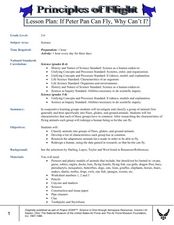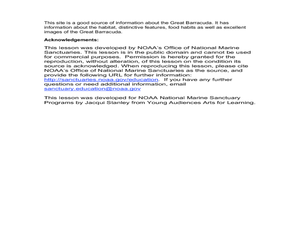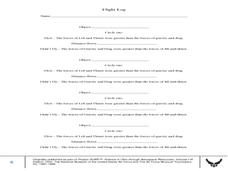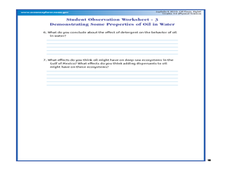Curated OER
Penguin Paradise
Students read about penguins and communicate their information in a one paragraph summary. In this penguin writing lesson, students review sentence construction. Students complete a KWL about penguins and read the book Penguins Through...
Curated OER
Getting to Know the Presidents
In this presidents worksheet, students use given web site sources to complete a graphic organizer comparing pairs of presidents, 5 pairs total.
Curated OER
Genetics Challenge
In this genetics worksheet, high schoolers fill in the blanks with terms related to genes, alleles, genotypes, phenotypes and heredity. They use their answers to complete a joke.
Curated OER
Classification of Life
In this classification of life worksheet, students use an on line source to answer questions about how species are classified, named and grouped. They give the classification of a bear, an orchid and a sea cucumber.
Curated OER
Design a Deep- Sea Vertebrate or Invertebrate
Students design a deep-sea animal. For this research based lesson, students research and design a vertebrate or invertebrate that lives in a methane hydrate habitat. They compile a class chart of the adaptations animals have in this...
Curated OER
My Winter Acrostic
Learners create an acrostic poem about winter. In this lesson about acrostic poems, students explore acrostic poetry. Learners read an acrostic poem as an example. As a class, students come up with an acrostic poem for the word "CLASS"....
Curated OER
If Peter Pan Can Fly, Why Can't I?
Students redesign a human, using data in research, so that s/he can fly. For this flying lesson, students examine the characteristics and adaptations of groups of animals that can fly. Using this research, students work cooperatively to...
Curated OER
Microscope Basics
In this microscope learning exercise, students label the parts of a microscope, they calculate the powers of magnification for each lens on the scope and they answer questions about making a wet mount slide.
Curated OER
Yucky Worm World
For this earthworm worksheet, students use an on line site to answer questions about the structures and their functions of an earthworm. They also answer questions about planarians, leeches and tapeworms.
Curated OER
Potato: A Tale from the Great Depression
Students barter for goods within the class. In this economics lesson based on the Great Depression, the teacher introduces the lesson with a picture book, then students are allowed to barter with teacher supplied goods as they examine...
Curated OER
This Old Tubeworm
Students plot data to construct and interpret a graph about vestimentiferans at cold-seep sites in the Gulf of Mexico. In this deep sea lesson, students plot data provided for the growth of tubeworms. They use the graphs to determine...
Curated OER
Staying Up
Students will explain the Archimedes's Principle. In this lesson on plankton, students will describe three factors that can affect the buoyancy of plankton. This lesson contains extensive background information, extensions, and multiple...
Curated OER
The Great Barracuda
Young scholars explore oceanography by researching the great barracuda. In this animal life lesson plan, students read several vocabulary terms dealing with ocean life and examine a drawing of a barracuda. Young scholars examine the...
Curated OER
Roman Archy
Third graders use Google Earth to examine Roman architecture. In this ancient Rome lesson, 3rd graders visit the noted URLs to look at examples of Roman architecture. Students work in teams to examine data about the structures.
Curated OER
U.S. foreign policy in the early Republic
Students research various events during the War of 1812 and then create magazine articles with supporting illustrations, students are in control of their learning.
Curated OER
Journey To the Unkown
Students explore the ocean rift habitat off the Galapagos through an audio expedition, Internet research on deep sea animals, an explorer game and simulation of the exploration of the deep sea bottom. They focus on the actual NOAA...
Curated OER
Birds & Caterpillars
In this biology worksheet, students explain the use of camouflage as a defense mechanism. Then they list examples of insects that use camouflage to protect them from predators. Students also identify and name other types of defense...
Curated OER
Life Has A History
In this biology worksheet, students identify and match various classes of species found today. Then they explain why biodiversity exists today on earth and define evolution. Students also describe who a paleontologist is and what they do.
Curated OER
Journey to the Unknown
Students explore the ocean depths. In this scenario based lesson plan, students pretend they are on a submarine in an unknown part of the ocean. By using clues the class discusses and determines where they are in the ocean. They follow...
Curated OER
Uncle Jed's Barbershop
Fourth graders examine productive resources. In this economics lesson, 4th graders read a book about a man who saves money to buy his own barbershop. After reading, students get into groups to play a game to learn about savings.
Curated OER
Household Things that Fly and Why!!!
Students examine the four forces of flight. In this flight lesson, students test to see which types of items will fly. Students make predictions on whether the item will fly or not. Students gain knowledge about lift, gravity, thrust and...
Curated OER
Classify Machines that Fly!
Eighth graders explore flight and the dichotomous key. In this flight lesson, 8th graders gain understanding of the dichotomous key and create one of their own. Students then use their dichotomous key to classify types of aircraft.
Curated OER
Lesson III: Crisis, Pearl Harbor, Internment
The third in a series of lessons introduced by “A Fence Away From Freedom,” uses the Smithsonian website, “A More Perfect Union: Japanese Americans and the U.S. Constitution” and focuses on the section of the presentation devoted to the...
Curated OER
Oil Floats, Right?
Young scholars examine the properties in oil in water. In this mixture lesson, students read about the Lophelia II 2010: Cold Seeps and Deep Reef Expedition and look at images of deep sea ecosystems. They experiment or participate in...

























